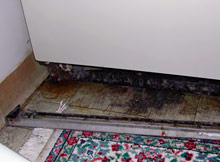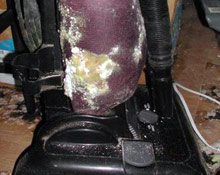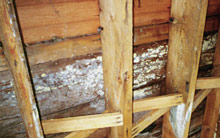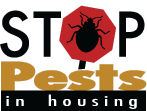- HOME
- » PEST SOLUTIONS
- » Mold
Mold
How to deal with mold
 |
|
Mold on a refrigerator drip plan. Photo courtesy of National Center for Healthy Housing. |
 |
|
Vacuum with mold. Photo courtesy of National Center for Healthy Housing. |
 |
|
Mold on sapwood. Photo courtesy of National Center for Healthy Housing. |
Keep the moisture down (30–60% humidity is good), you’re well on your way to solving or preventing a problem. Use dehumidifiers, bathroom fans, and good ventilation.
If flooding occurred, take things that were wet for two or more days outside then brush mold off them. Take stuff made of cloth outside if it can’t be washed in hot water. Also, take things that can’t be washed outside like paper, leather, wood, and rugs.
Most household cleaners will clean mold off hard surfaces, like counters, dishes, toys, and appliances. To clean moldy areas or items, wear rubber gloves, eye-protection, and an N95 respirator to protect yourself from the mold spores.
Most items can be cleaned with a household cleaner or soapy water. If using bleach, open windows and doors to let in fresh air. Never mix more than 1 cup per one gallon of water. Always use bleach and other cleaners according to the label. Note: never mix bleach and ammonia or other cleaning products.
What they look like
Though not your traditional pest, these fungi are potential problems for sure. Some make mushrooms; some make mold and mildew. No need to get technical with names: if you see fuzzy patches on your house or stuff, take action.
Where they live
Mold spores—sort of like microscopic seeds—float about in the air, pretty much everywhere. When they land on a hospitable surface, they start to grow. What’s a good spot for a house-pest spore? Moisture and warmth. Which is why you find them in showers, damp basements, and kitchens.
What they do
Mold colonies—the fuzzy spots—on your walls, refrigerator seal, and leather goods are—slowly—eating away at your house and your stuff. Some people are allergic to mold and a few molds cause disease. Molds on food aren’t usually a good sign either (unless you like blue cheese) but they’re not the ones that grow on the wall.
RESOURCES
EPA’s Mold Resources
EPA's Keep Your Home and Family Safe After a Flood
Mold in Your Home Video from the Northwest Clean Air Agency
EPA’s Moisture Control Guidance for Building Design, Construction, and Maintenance
See results from the Northeastern IPM Center’s resources database.
